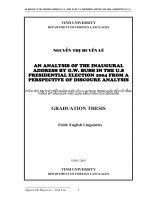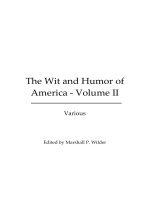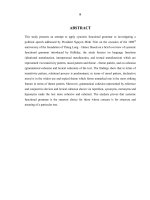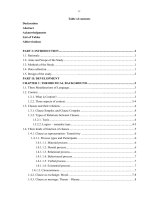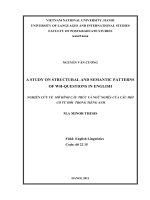The meaning and structure of the inaugural address by John F. Kennedy in 1961 A systemic functional analysis = Cấu trúc và ngữ nghĩa bài diễn văn nhậm chức của
Bạn đang xem bản rút gọn của tài liệu. Xem và tải ngay bản đầy đủ của tài liệu tại đây (1.77 MB, 103 trang )
VIETNAM NATIONAL UNIVERSITY, HANOI
UNIVERSITY OF LANGUAGES AND INTERNATIONAL STUDIES
FACULTY OF POST - GRADUATE STUDIES
************
NGUYỄN THỊ KIM OANH
THE MEANING AND STRUCTURE OF
THE INAUGURAL ADDRESS BY JOHN F. KENNEDY
IN 1961: A SYSTEMIC FUNCTIONAL ANALYSIS
CẤU TRÚC VÀ NGỮ NGHĨA
BÀI DIỄN VĂN NHẬM CHỨC CỦA JOHN F. KENNEDY NĂM 1961:
PHÂN TÍCH THEO QUAN ĐIỂM CHỨC NĂNG HỆ THỐNG
M.A. MINOR PROGRAMME THESIS
Field: English Linguistics
Code: 60220201
Hanoi - 2014
VIETNAM NATIONAL UNIVERSITY, HANOI
UNIVERSITY OF LANGUAGES AND INTERNATIONAL STUDIES
FACULTY OF POST - GRADUATE STUDIES
************
NGUYỄN THỊ KIM OANH
THE MEANING AND STRUCTURE OF
THE INAUGURAL ADDRESS BY JOHN F. KENNEDY
IN 1961: A SYSTEMIC FUNCTIONAL ANALYSIS
CẤU TRÚC VÀ NGỮ NGHĨA
BÀI DIỄN VĂN NHẬM CHỨC CỦA JOHN F. KENNEDY NĂM 1961:
PHÂN TÍCH THEO QUAN ĐIỂM CHỨC NĂNG HỆ THỐNG
M.A. MINOR PROGRAMME THESIS
Field: English Linguistics
Code: 60220201
Supervisor: Prof. Dr. Hoàng Văn Vân
Hanoi -2014
i
DECLARATION
I declare that the thesis entitled ―The meaning and structure of the inaugural
address by John F. Kennedy in 1961: A systemic functional analysis‖ reports the
results of the study conducted by myself in fulfillment of the requirements of the
degree Master of Arts. It has not been submitted for any other degree at any other
institution.
Hanoi, January 2014
Nguyen Thi Kim Oanh
ii
ACKNOWLEGEMENTS
I would like to express my deep gratitude to my supervisor, Prof. Dr. Hoàng
Văn Vân for his untiring and practical assistance throughout the process of my
writing. Without his responsible help and enthusiastic guidance, I would not have
been able to complete this thesis.
I greatly wish to acknowledge my thanks to my classmates at the University
of Languages and International Studies for their informative and constructive
comments on my study. Had it not been for their suggestions, this thesis could not
have been fully completed.
Finally, my big thanks go to my beloved husband for his constant support
and unconditional care while I was writing this thesis.
Hanoi, January 2014
Nguyễn Thị Kim Oanh
iii
ABSTRACT
This study applies systemic functional grammar in order to investigate the
meaning and structure of the inaugural address by John F. Kennedy in 1961. Based
on the framework of systemic functional grammar developed by Halliday, the study
focuses on analyzing the text in terms of language functions (three metafunctions)
and cohesion (grammatical and lexical cohesion). The findings reveal that in terms
of transitivity, material process is predominant; in terms of mood, declarative mood
is in the largest use; and in terms of theme, topical theme which forms unmarked
one is the most notable feature in the whole text. Besides, grammatical cohesion
presented by reference, conjunctive devices and structural parallelism and lexical
cohesion illustrated through repetition, synonymy, and antonymy make a great
contribution to the cohesion and coherence of the text. Undeniably, the analysis
proves that this text is really meaningful, concise, and highly cohesive with the
diversified uses of lexis and structures and so systemic functional grammar is an
effective tool for analyzing the structure and meaning of a particular text.
iv
TABLE OF CONTENTS
ACKNOWLEDGEMENTS ii
ABSTRACT iii
TABLE OF CONTENTS iv
LIST OF TABLES vi
LIST OF NOTATIONAL CONVENTIONS AND ABBREVIATIONS vi
PART A: INTRODUCTION 1
1. Rationale of the study 1
2. Aim of the study 1
3. Scope of the study 2
4. Methodology of the study 2
5. Data collection 2
6. Design of the study 2
PART B: DEVELOPMENT 4
CHAPTER 1: THEORETICAL BACKGROUND 4
1.1. Form and meaning 4
1.2. Model of Context in systemic functional linguistics 5
1.3. Clause and Clause complex 5
1.3.1. Clause simplex and Clause complex 5
1.3.2. Clause combination 6
1.3.2.1. Interdependency 6
1.3.2.2. Logico – semantic relation 6
1.4. Metafunctions 7
1.4.1. Ideational metafunction 7
1.4.1.1. Process types and participants 8
1.4.1.2. Circumstances 12
1.4.2. Interpersonal metafunction 13
1.4.2.1. Mood 14
1.4.2.2. Residue 14
v
1.4.3. Textual metafuntion: theme and rheme identification 15
1.5. Cohesion 16
1.5.1. The concept of cohesion 16
1.5.2. Types of cohesion 16
1.5.2.1. Grammatical cohesion 16
1.5.2.2. Lexical cohesion 21
1.6. Summary 22
CHAPTER 2: THE MEANING AND STRUCTURE OF THE INAUGURAL
ADDRESS BY JOHN F. KENNEDY IN 1961 24
2.1. Introduction 24
2.2. The context of the chosen text 24
2.3. Contextual configuration of the text 25
2.4. Clause and clause complex analysis 27
2.5. The analysis of the text in terms of Transitivity, Mood and Theme 28
2.5.1. The Transitivity pattern of the text 28
2.5.2. The Mood pattern of the text 30
2.5.3. The Thematic pattern of the text 32
2.6. The Cohesion of the text 33
2.6.1. Grammatical cohesion 33
2.6.2. Lexical cohesion 35
PART C: CONCLUSION 39
1. Recapitulation 39
2. Implications of the study 40
3. Suggestions for further study 41
REFERENCES 42
APPENDIX I
vi
LIST OF TABLES
Table 2.1: The principal types of relational process 11
Table 2.2: Circumstantial elements 13
LIST OF NOTATIONAL CONVENTIONS
||| Clause complex boundary || Clause boundary
1.1 1.2 1.3 … Paratactic relation α β …Hypotactic relation
= Elaboration + Extension
x Enhancement Anaphoric reference
Cataphoric reference Exophoric reference
LIST OF ABBREVIATIONS
Act Actor R: C Comparative reference
ANT Antonym R: D Demonstrative reference
Attr Attribute Re Relational
Car Carrier REP Repetition
Cir Circumstance R: P Personal reference
Compl Complement SFG Systemic functional grammar
Fin Finite Sen Senser
Mat Material Subj Subject
Men Mental SYN Synonym
Phenom Phenomenon Verb Verbal
Pred Predicator
1
PART A
INTRODUCTION
1. Rationale of the study
The long history of linguistics has witnessed the development of various
approaches to grammar study, among which systemic functional grammar (SFG)
emerged as ―an effective tool of analysis, which solves the issues left out by
traditional grammar‖ since it helps understand human language more deeply. Of
the linguists investigating this approach, Halliday is the eminent one to suggest the
most practical approach to the grammatical construction be meaning–centered as he
considers language a ―system of meanings‖. From this view, functional grammar
emphasizes how linguistic structures express meaning and view language as a
communicative resource, not just as isolated grammatical rules. However, the
process of teaching and learning the language sometimes, in fact, seems to make a
clear distinction between grammar and other linguistic areas, so the communicative
language acquisition is not really completed.
As a teacher of English for a number of grammar classes, I am deeply
interested in improving the language proficiency along with the structure accuracy
for my students. That is the reason why I have developed a great attention to SFG
and my absorption in it helps strengthen my notion of its applications in language
teaching and learning.
In this study, the analysis of structure and meaning of the inaugural address
by John F. Kennedy in 1961 is conducted. This political text is chosen to investigate
due to the fact that it has been considered one of the best speeches of 20
th
century
worldwide. It may provide a rich context of language for applying SFG to analyze.
2. Aim of the study
The main aim of the thesis is to analyse the inaugural address by John F.
Kennedy in 1961 in terms of transitivity, mood, theme, and cohesion using systemic
functional grammar as the theoretical framework.
2
To realize this aim, the research question is as follows:
How is the inaugural address by John F. Kennedy in 1961 organized in terms
of transitivity, mood, theme, and cohesion?
3. Scope of the study
Within the scope of a minor thesis, it is impossible to analyze the text in all
aspects as developed by systemic functional grammar framework. Therefore, the
thesis will focus on re-examining the theoretical concepts relevant to the study and
will use them to analyze the meaning and structure of the inaugural address by John
F. Kennedy.
4. Methodology of the study
Description and analysis are two main methods to analyze the meaning and
structure of the speech. The former deals with the illustration of the crucial areas of
functional grammar and the latter is concerned with the analysis of the text for
discussion.
5. Data Collection
The inaugural address by John F. Kennedy in 1961 is retrieved from the
official and popular website
6. Design of the study
There are three main parts in this thesis as follows:
Part A: Introduction - gives an overview of the rationale, aims, scope,
methodology and design of the study
Part B: Development
- Chapter 1: Theoretical Background – provides an overview of
systemic functional grammar in which crucial concepts relevant to the study
are examined.
- Chapter 2: The analysis of the inaugural address by John F.
Kennedy in 1961 – focuses on analysing its meaning and structure, based on
the framework provided in chapter 1.
3
Part C: Conclusion - summarizes the results of the research and suggests
some implications for language teaching and learning as well as for further
studies.
4
PART B
DEVELOPMENT
CHAPTER 1
THEORETICAL BACKGROUND
This section will re-examine some fundamental concepts in systemic
function grammar to provide theoretical orientations for the analysis of the
inaugural address by John F. Kennedy in 1961 including form and meaning, model
of context in systemic functional linguistics, clause and clause complex,
metafunctions, and cohesion. Examples are extracted from functional grammar
works by well-known linguistics such as Halliday and Hasan (1976), Halliday
(1994), Thompson (1996) and Hoang Van Van (2006).
1.1. Form and Meaning
Both form and meaning approaches try to find out the answer to the question
of language features. Beginning in 1950s, formal grammar, which was developed
by Noam Chomsky and his followers, is concerned with description of the structure
of individual sentences. These linguists intend to explain the language structure in
the way it is. At the same time, a set of rules for grammatically correct or incorrect
usage are established as the guide for language users. In other words, that a sentence
or utterance is viewed to be wrong or right is due to its obedience to the laws of
grammar.
Unlike the formal linguists, functional linguists have generally dedicated
themselves to addressing practical concerns of the application of grammar as well
as relating grammar to its function within society. Specifically, Halliday (1994)
views language not as a system of rules but ―a system of meanings‖. It shows how
people use language to make meaning in order to navigate their social interactions
on their lives. He suggests the most practical approach to the grammatical
5
construction should be meaning–centered. In other words, the communicative
purposes and choices, or the sentence-utterance meaning plays an indispensable part
in linguistics. That is the reason why systemic functional linguistics takes language
to its functions through meaning, not just formation.
1.2. Model of Context in systemic functional linguistics
Considering linguistics a branch of sociology, a social semiotic which
enables people to exchange meaning and therefore act socially, Halliday used the
concept of context of situation and cultural context as the basis of his work. He
developed the conceptual framework for illustrating the context including three
dimensions named as field, tenor, and mode. In Halliday‘s view:
Field of Discourse: refers to the subject matter: what is happening, to whom,
where and when, and why it is happening …
Tenor: deals with the social relation existing between participants. Tenor
influences interpersonal choices in the linguistic system, and thereby it affects
role the structures and the strategies chosen to activate the linguistic exchange.
Mode: describes the way the language is being used in the speech interaction,
including the medium (spoken, written, written to be spoken) as well as the
rhetorical mode (expository, instructive, persuasive).
Briefly, these three components offer a system which helps illustrate any
socio-linguistic occurrence. They are also the working hypothesis of metafunctions.
Halliday (1994) figures out that the field determines ideational meaning, tenor
represents interpersonal meaning, and mode corresponds to textual meaning.
1.3. Clause and Clause Complex
1.3.1. Clause simplex and Clause Complex
Halliday classifies clauses into two types named clause simplex and clause
complex. A clause simplex contains only one clause whereas a clause complex is
composed of a head clause together with other clauses that modify it. The notion of
‗clause complex‘ can be assumed to enable us to account in full for the functional
organization of sentences (Halliday, 1994: 216). Here are some illustrations:
6
Clause simplex || They lived in a large house ||
Clause complex ||| You never can tell || till you try |||
(Halliday, 1994: 223)
1.3.2. Clause combination
According to Halliday (1994), the relationship between clauses can be
interpreted as one of modification. The enrichment of the concept of modification
will enable systematic alternatives into two dimensions: interdependency (taxis) and
logico- semantic relation.
1.3.2.1. Interdependency
This dimension represents the relation of modifying, where one element
modifies or is modified by other elements in the clause. Therefore, the relation is
dependent or equal due to the modification. If it is unequal with at least one
dominant factor, the relationship is named as hypotaxis. If there is equality among
elements, it is called as parataxis.
Hypotaxis: the relation between a dependent element and its dominant.
Hypotaxis structures will be described by the Greek letter notation (α, β).
Parataxis: the equal relation between elements. In other words, the elements are
independent. For paratactic structures, numerical notation (1, 2, 3…) will be
used for illustration.
In fact, a typical clause complex is a combination of hypotactic and paratactic
sequences, so it will be impractical if they are separated in analysis. For instance,
the following clause complex can be viewed as:
||| I would || if I could, || but I can‟t |||
1α 1β 2
(Halliday, 1994: 218)
1.3.2.2. Logico – semantic relation
The second dimension of clause combination looks at the nexus between
clauses in a variety of logico-semantic relation. However, two most fundamental
relationships include (i) expansion and (ii) projection.
7
(i) Expansion: the secondary clause expands the primary one by elaborating,
extending or enhancing it. This system consists of the following choices:
Elaborating (i.e.): restating in other words, making the clause clearer,
commenting and giving illustration. For instance:
||| That clock doesn‟t go; || it‟s not working. |||
Extending (and, or): adding new information, providing a replacement or an
alternative. Here is an example:
||| I would have let you know, || only I couldn‟t find your phone number. |||
Enhancing (so, yet, then): giving circumstantial characteristics of time, place,
manner, cause, or condition. For instance:
||| Alice didn‟t want to begin another argument, || so she said nothing. |||
(ii) Projection: the secondary clause is projected by the primary clause as what
somebody said (a locution) or thought (an idea). This system comprises the
following choices:
Locution (say) : a construction of wording
||| „I‟m not so sure,‟ || replied the Fat Controller. |||
Idea (think) : a construction of meaning
||| Dr Singleman believed || his patient would recover. |||
(Halliday, 1994)
1.4. Metafunctions
Halliday (1994) considers metafunctions one of basic concepts around which
systemic grammar theory is constructed as the concept of metafunctions refers not
simply as the characteristics of the clause but also the meaning running throughout
the whole language. Metafunctions, in his point of view, are divided into three
broad functions of language, known as ideational, interpersonal and textual
metafunctions.
1.4.1. Ideational metafunction
Ideational metafunction represents the idea that language serves for the
expression of content; in other words, the speaker‘s background knowledge and
8
experience, including his own awareness. The clause plays a central role as
representation including the principles, which are made up of processes. Meanwhile
the clause is also a mode of reflection achieved through the grammatical system
namely transitivity referring to as a set of process types. The process types, in
general, express the ―goings-on, happening, doing, sensing, meaning, being and
becoming‖ (Halliday, 1994). The transitivity system is concerned with six process
types: material, mental, relational, behavioural, verbal and existential.
The framework of a process involves three main components:
The process itself: realized typically by verbal groups
Participants in the process: realized typically by nominal groups
Circumstances associated with the process: realized typically by adverbial group
or prepositional phrase.
The concepts of process, participants and circumstances are semantic
categories, which provide the linguistic structure of the events in reality.
1.4.1.1 Process types and participants
Each type of process contributes to the construction of English grammar and
there are specific kinds of participants associated with it in particular circumstances.
Material process
This type of process carries out the meaning of actions, or some entity
―does‖ something, - which may have some influences on other entities. The ―doer‖
of the action is called Actor. In many cases, the actions may be referred as affecting
to the second participant in the process; this one is known as Goal. The actor and
goal can be either human or inanimate. Here is an example:
The lion
caught
the tourist
Actor
Process: material
Goal
Moreover, material processes are not necessarily a concrete or physical
activity. They might be abstract doings or happenings as what Halliday illustrates in
the following example.
9
The mayor
resigned.
Actor
Process: material
In a number of material processes, when there are more than two
participants, the one benefiting from the process is called Recipient. For instance:
Tom
gave
me
some flowers
Actor
Process: material
Recipient
Goal
Mental process
This type of process expresses the processes of feeling, thinking, and seeing.
The participant who is the conscious being that is feeling, liking and seeing is
named Senser. The sensed, felt, liked, thought or seen participant is called the
Phenomenon. Furthermore, according to Hoang Van Van (2006), mental process is
classified into 4 sub-types:
Perceptive: seeing, hearing…
Affective: liking, fearing…
Cognitive: thinking, knowing, and understanding…
Desiderative: wanting, desiring, wishing
Tim
could hear
the speaker
Senser
Mental process: perceptive
Phenomenon
I
don‟t like
it
Senser
Mental process: affection
Phenomenon
The students
understood
the problem
Senser
Mental process: cognitive
Phenomenon
Kate
wants
a well-paid job
Senser
Mental process: desiderative
Phenomenon
10
Verbal process
This is the process of saying, not simply the action of speaking out some
notions but also the symbolic exchange of meaning. Therefore, in I told you or The
guide book tells everything, both ―I‖ and ―The guide book‖ are the participant which
is named Sayer. The verbal process includes not only Sayer but Receiver (the one
to whom the process is aimed), Verbiage (content of what is said or name of the
saying), and Target (the thing that is targeted by the process) as well. The
following are some illustrations:
He
told
me
the truth
Sayer
Process: verbal
Receiver
verbiage
She
praised
him
to her friends
Sayer
Process: verbal
Target
Receiver
The relationship of quoting or reporting is also demonstrated in this type of process.
She
said:
“I‟m tired”
Sayer
Process: verbal
Quoted
She
said
that she would go away
Sayer
Process: verbal
Reported
Relational process
The third type of processes is relational, something is being said to be
something else. It comes under three main kinds:
(+) Intensive: X is A
(+) Circumstantial: X is at A (refers to location)
(+) Possessive: X has A
Each of these comes in two distinct modes:
(+) Attribute: A is an attribute of X
11
(+) Identifying: A is the identity of X
Halliday offers the principal types of relational process as the following:
Attributive
Identifying
Intensive
Sarah is wise.
The leader is Tom.
Tom is the leader.
Circumstantial
The fair is on a Tuesday.
Tomorrow is the 10th.
The 10th is tomorrow.
Possessive
Peter has a piano.
The piano is Peter‟s.
Peter‟s is the piano.
Table 2. 1: The principal types of relational process
In Atributive mode, one participant is known as Carrier and the quality to
represent the possessive relation of carrier is referred to as Attribute. For instance:
Your story
sounds
completely nonsense
Carrier
Process: relational
Attribute
In Identifying mode, there is a clear distinction between the identifying and
identified participants. This pair is termed as Identifier/ Identified and Token/
Value. For example:
Tom
is
the leader
Identified/ Token
Process: relational
Identifier/ Value
In some cases, the possessive relationship can be referred as Possessor and
Possessed. For example:
Peter
has
a piano
Possessor
Process: relational
Possessed
Behavioral process
This type of process illustrates the physiological and psychological behaviors
such as cough, smile, dream although it seems to share the characteristics of mental
12
and material process. The participant who behaves is the Behaver and this
participant is always a conscious being, not a lifeless thing. There are five kinds of
this process as Halliday suggests:
Processes of consciousness as form of behavior: look, watch, stare
Verbal processes as behavior: chatter, grumble, talk
Physiological processes manifesting states of consciousness: cry, laugh
Other physiological processes: breathe, faint, sleep
Bodily postures and pastimes: sing, dance, lie
Normally, there is one participant in behavioral process:
She
cried
in silence
Behaver
Process: behavioral
Circumstance
Existential Process
This indicates that something exists or happens. Normally, the word There
will appear in the process as the subject without representational function. This
process typically involves the verb be and other verbs to express the existence or
happening such as exist, remain, arise, occur.
The object or event which is being said to be existent is known as Existent.
It can be an entity or an event that takes place. The following are some examples:
There
is
a storm
Process: existential
Existent : event
There
is
someone
outside
Process: existential
Existent: entity
Circumstance
1.4.1.2 Circumstantial elements
Circumstances express the notion of ―When, where, how and why‖ the
process takes place. Circumstantial factors can be adverbial group or prepositional
phrases. Halliday (1994: 151) presents a ―fairly arbitrary list‖ of nine main
circumstantial elements as the following:
13
Type
Specific categories
Examples
1
Extent
Distance, duration
I walked for 10 miles
It occurs throughout the
year
2
Location
Place, time
At the party
At night
3
Manner
Means, quality,
comparison
I was hit with a stick
He sings loudly
She is like a princess
4
Cause
Reason, purpose,
behalf
Because of his illness
For the sake of us
On behalf of
5
Contingency
Condition,
concession, default
In case of
In spite of
In the absence of
6
Accompaniment
Comitation, addition
He came with me.
Jane came as well as me
7
Role
Guise, product
I talked as a representative
She is turning into another
person
8
Matter
She is worried about her
son.
9
Angle
According to the author
Table 2.2: Circumstantial elements
1.4.2. Interpersonal metafunction
Interpersonal metafunction is constructed on the idea that a clause can act as
an exchange. The communicative exchange purpose may be ordering, apologizing,
confirming, inviting, rejecting, evaluating and so on. However, the most basic ones
are demanding and giving the language commodity, or information and ―goods and
14
services‖ (Halliday, 1994). In carrying the exchange of interactive relations, a
clause can be seen as consisting of two components: mood and residue.
1.4.2.1 Mood
The mood shows what role the speaker selects in the speech situation and
what role he assigns to the addressee. In English, it includes two elements: (i)
subject and (ii) finite.
(i) Subject is a similar term from traditional grammar. It supplies the rest of what it
takes to form a proposition, something by reference to which the proposition can be
affirmed or denied.
(ii) Finite can be used to make reference to time of speaking (temporal operator) or
to the judgment of speaking (modal operator). Sometimes, it is obvious to find out
finite as in the cases when auxiliary or modal verbs are separated. For example:
Did you invite her to the party?
I can go with you.
However, finite can be mixed with lexical verbs in simple present and simple past
tense. Here are some examples:
The sun sets in the West.
I took the exam yesterday.
1.4.2.2 Residue
The other element of a clause is called residue. This part consists of three
subfactors: (i) predicator, (ii) complement, and (iii) adjuncts.
(i) Predicator: is expressed by the verbal group. It is also an indispensable section
of any clause. The predicator presents the action, happening state…in which the
subject is involved.
(ii) Complement: is realized by a nominal group. The orders of complement and
subject will have an influence on thematic purposes of the clause.
(iii) Adjuncts: is performed by an adverbial group or a prepositional phrase.
In summary, the following sample (Thompson, 1996) can illustrate the
interpersonal metafunction once again:
15
In the following day
he
did not
go
out
early
Adjunct
Subject
Finite
Predicator
Adjunct
Adjunct
Residue
Mood
Residue
1.4.3 Textual metafunction: theme and rheme identification
The metafunction which gives the clause the characteristics of a message is
the thematic structure. In any clause, there is one element, which ―serves as the
point of departure‖ namely Theme and the remainder of the clause, which develops
Theme in order to complete the message of the clause, is known as Rheme.
As ―the starting point of the message‖, theme is commonly supposed to be at
the beginning rather than the end of the clause. Theme can be a nominal group, an
adverbial group or a prepositional phrase. The following are some examples:
My husband
is an engineer.
Theme
Rheme
Long ago,
I lived in this village.
Theme
Rheme
In silence,
he got into the house.
Theme
Rheme
When theme stands at the first place as a subject of the clause, it is
unmarked due to the obvious role it is supposed to play. On the other hand, any
themes other than the subject in a declarative are referred to as marked theme.
Most common form of marked theme is a circumstance or a complement. Some
illustrations are the following:
I
was there
Unmarked theme
Rheme
16
In 2010,
we moved to this city
Marked theme
rheme
Nature
I loved
Marked theme
rheme
Theme can be single with only one constituent or multiple with further
internal structure. Theme can also be classified into topical (if conflated with
experiential components), textual (relevant meaning to discourse) and interpersonal
(referring to speakers and listeners interaction).
In short, the thematic structure in which theme is the prominent element can
be analyzed to ―gain an insight into its (the text) texture and understand how the
writer made clear to us the nature of his underlying concerns.‖ (Halliday, 1994: 67)
1.5. Cohesion
1.5.1. The concept of cohesion
Nguyen Hoa (2000: 23) defines cohesion as ―the formal relationship that
causes texts to cohere or stick together‖. It is a wide range of semantic relationships
conveyed through clauses. It occurs where the interpretation of some elements in
the discourse is dependent on that of another, the one presupposes the other.
Actualization of cohesion depends on both selection of some option from
systematic resources (reference, ellipsis, substitution, conjunction and structural
parallelism) and the presence of some other elements (repetition, synonym,
antonym, meronymy and collocation) which resolves the presupposition that this
sets up. They all fall into two main types of cohesion namely grammatical cohesion
and lexical cohesion which will be discussed in the following parts.
1.5.2. Types of cohesion
1.5.2.1. Grammatical cohesion
Grammar, in linguistics, refers to the logical and structural rules that govern
the composition of sentences, phrases or words of any given languages.
Grammatical cohesion, thus, refers to the logical and structural content of a text.
17
Reference
According to Hoang Van Van (2006: 66), reference illustrates the
relationship of identity which exists between units in discourse. It can be classified
into six main sub-types:
Anaphoric reference: directs listeners or readers to refer ―backwards‖ to the
preceding text to get a comprehensive understanding of the discourse. In the
analysis, it is indicated by a backward arrow. For example:
Look at the sun. It‟s going down quickly.
Cataphoric reference: refers ―forwards‖ the clause so as to specify the reference
meaning. In the analysis, it is illustrated by a forward arrow. For instance:
As she arrived home, Janet noticed that the door was open.
Exophoric reference: refers ―outwards‖ the clause to some participants in the
previous part. In the analysis, it is indicated by a vertical arrow. For example:
The man turned out to be a thief.
Personal reference: is the reference to the category of human participants,
using pronouns. In the analysis, it is indicated by (R: P). Here is an example:
I and my mother are at the market. We want to buy some fruits.
Personal reference (R: P)
Comparative reference: is for the purpose of illustrating comparison,
similarities or identities, comparative reference are expressions such as the
same, similar to, more than, the most, as good as… In the analysis, it is
indicated by (R: C). Here is the example:
She cooks much better than her sister.
Comparative reference (R: C)
Demonstrative reference: is a form of verbal pointing by speakers who
identifies the referent by locating it on the scale proximity in terms of time and
space. It‘s normally expressed through determiners like this, that, these, those,
and adverbs like here, or there. In the analysis, it is indicated by (R: D). Here is
an example:

